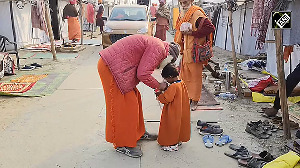With tariff and non-tariff barriers still in place, the World Trade Organisation has said market access for textiles and clothing products remain an issue.
In its 2003 annual report, the trade body said tariff peaks remained a problem in the United States, the European Union and Canada with the average tariff on textile products considerably higher than the overall simple average duties. In the case of developing countries like India and Bangladesh, tariffs were even higher, it added.
"For some countries, notably South Africa and, to a lesser extent, Japan, tariffs on textiles and clothing tend to have a larger share of specific duty elements, including compound and alternate rates, than other products.
The specific duties are generally not included in tariff calculations and it is likely that their use will further increase the overall average," it said.
The multilateral body said quantitative restrictions for reasons other than those in the Agreement on Textiles and Clothing were being removed.
The WTO was, however, critical of the items for which quotas were lifted in accordance with the textile agreement and said products selected for integration were concentrated in the lower value-added range.
"Integration in the third stage will not alter this observation significantly, probably implying that the value of products integrated during the three stages will be lower than in volume terms," the report said.
The concentration on low-value products will also tend to imply that there is escalation in non-tariff protection.
The first two stages (1995-97 and 1998-2001) for the integration of textiles and clothing products into the rules of the General Agreement on Trade and Tariff, 1994, have been completed with the final stage, 2002-04, being currently implemented.
Members were required to integrate 16 per cent, 17 per cent and 18 per cent of their total volume of imports of textiles and clothing covered by the Agreement on Textiles and Clothing at the beginning of each of the three stages, respectively.
Most countries that undertook integration programmes under the Agreement on Textiles and Clothing have met the minimum requirements. However, little progress has been made in the overall elimination of restrictions, except in the case of Norway, which phased out all its restrictions between 1996 and 2001.






 © 2025
© 2025